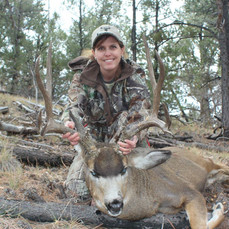Unit 12A West Late Rifle Mule Deer: Hunt Overview
- Dillon Currie
- May 23, 2022
- 4 min read
Updated: Nov 21, 2023
The world-famous "Kaibab" conjures up Mule Deer hunting dreams of spectacular non-typical points adorning the 30" wide antlers of bucks. It is ground that has made many Muley dreams come to fruition, while humbling equally as many would-be trophy hunters in their pursuits. The landscape itself inspires grandeur and fascination as greatly as it's famous four-legged residents command. Rising dramatically above the surrounding arid lowlands, the Kaibab Plateau is prominent both geologically and in the eyes nearly all serious Mule Deer hunters. The 1,152 square miles of rock comprising the plateau sores to 9200' at its highest point. Aspen and mixed-conifer forests cover the upper terrain, while pinyon-juniper woodland dominates in the lower country. There are few places quite like "The Bab" when it comes to a century long history of giant deer producing hunting seasons. The naturalist, ecologist, and author Aldo Leopold, who laid a significant portion of the groundwork for modern scientific wildlife and land management, made famous the Kaibab deer population in the early 1900's. During that time the area experienced a radical shift in Mule Deer numbers, highlighting the serious ramifications human intervention can have on particular specie's populations.
Unit 12A West occupies the area north of highway 89 and west of the Grand Canyon highway 67, north of the National Park boundary to the Kanab Creek drainage, along the creek to the Kaibab National forest boundary, crossing 67, back to it intersection with highway 89. The "West-side" encompasses a significant portion of the plateau's early, mid-season, and winter-range Mule Deer habitat. While herds spend their summer months at higher elevations, the late season "trophy" hunt occurs when deer traditionally begin to migrate into the winter country. Deer activity is high as the rut ensues, bringing many of the older and largest bucks our into glassable terrain. Seeing hundreds of Mule Deer a day is not uncommon on the Kaibab. Inclement weather is to be expected in late November and with the remote location of the unit preparation is mandatory as very few services are available. Cold temps and snow may drive the deer lingering herds from the higher elevation transitional areas. This phenomena is an incredible spectacle to witness. For any Mule Deer fanatic, a late rut hunt in 12AW represents one the highest quality hunting experiences in all of North America.
*Check out our Deer Hunt Application Picks page for info on our preferred draw choices for the year.*
What does it take to draw a 12A West Late Rifle Mule Deer tag?
If you're in a hurry to cash in your Bonus Points and chase monster Mule Deer bucks, I hate to be the bearer of bad news. Plan on waiting, to draw any Kaibab tag, especially 12AW late. This sub-unit and the surrounding ones, including those of "The Strip" in 13A and B, are the most desired Mule Deer tags in Arizona. If you do not have maximum Bonus Points don't get your hopes up. Patience and a bit of luck are key. The good news, 80% of tags will be allocated randomly, as with every other draw hunt. Any given year, regardless of your points, you still may draw a tag. After all, someone has to get them. I have personally witnessed numerous people close to me drawing these tags without max points, myself included. For instance, I drew my personal tag in 2008 with only 3 points total. I had 1 Bonus Point from not drawing in 2007 plus both an additional Loyalty Point and my permanent Hunter's Education point. Inexplicably, my sister drew 12A West late rifle tags in 2006, 2007, and 2009! I wouldn't expect to have her kind of good fortune, but its not impossible.
2nd Season November "Trophy": Residents 100% @ 24-17 BPs, 0.2% @ 0BPs. Non-Residents 100% @ 24 BPs, <0.01% @ 0BPs
How does Unit 12AW compare to other hunts?
There is not much of a comparison to be made here, with the exception of the other unit 12 and 13 hunts. It is my opinion that 12A West late offers the best hunt experience of its class with the highest deer numbers, premier habitat, history, access, and probability of taking a once-in-a-lifetime animal. There is no shortage of opportunity here for a good or great buck and few places on earth where 200" deer are a possibility. In reality however, only a limited amount of hunters are going to shoot objectively "giant" deer. If you want the best chance possible to do so, there aren't many substitutes unless your'e willing and able to write absurdly large checks for landowner tags elsewhere.
In contrast to every other Mule Deer hunt option south of The-Ditch, the Kaibab is the crown jewel. Quality rules there. As a result, expect to wait. It could take 20+ years to accrue enough points to draw a tag unless the luck-of-the-draw is on your side. Non-residents are going to have the slimmest odds, but that stands true for every hunt because of the 10% cap on non-resident tag allocation. Of that 10%, no more than half will go to those with max Bonus Points and half will be random-draw applicants. The wait for tags is the biggest downfall of any trophy management unit, for any species. There are simply too few tags and too many hunters hoping for their opportunity.
My family has an extensive history hunting deer on the Kaibab going back to at least the 1950's. The good-old-days of station wagon hunting, predictable Thanksgiving snow storms, and guaranteed tags are a thing of the past but the allure still remains.
The application Deadline for Arizona deer is the second Tuesday in June. "You can't win if you don't play." To book a hunt or for more information, contact Dillon Currie at (623) 606-3364 or hunts@chasentheking.com.






























Commenti